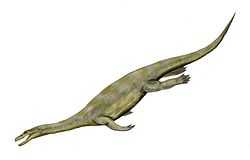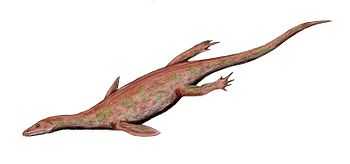Nothosaur
| Nothosaurs Temporal range: Triassic | |
|---|---|
 | |
| Nothosaurus | |
| Scientific classification | |
| Kingdom: | Animalia |
| Phylum: | Chordata |
| Class: | Reptilia |
| Superorder: | †Sauropterygia |
| Order: | †Nothosauroidea Baur, 1889 |
Nothosaurs (order Nothosauroidea) were Triassic marine sauropterygian reptiles that may have lived like seals of today, catching food in water but coming ashore on rocks and beaches. They averaged about 3 metres (10 ft) in length, with a long body and tail. The feet were paddle-like, and are known to have been webbed in life, to help power the animal when swimming.[1] The neck was quite long, and the head was elongate and flattened, and relatively small in relation to the body. The margins of the long jaws were equipped with numerous sharp outward-pointing teeth, indicating a diet of fish and squid.
Taxonomy
The nothosaurs consist of two suborders:
- Pachypleurosauria, small primitive forms, and
- Nothosauria, (including Ceresiosaurus, Lariosaurus, and Nothosaurus), which evolved from pachypleurosaurs.
Nothosaur-like reptiles were in turn ancestral to the more completely marine plesiosaurs, which replaced them at the end of the Triassic period.
References
- Fantastic Facts About Dinosaurs (ISBN 0-7525-3166-2)
- Benton, M. J. (2004), Vertebrate Paleontology, 3rd ed. Blackwell Science Ltd classification
- Colbert, E. H., (1969), Evolution of the Vertebrates, John Wiley & Sons Inc (2nd ed.)
- Rieppel, O., (2000), Sauropterygia I, placodontia, pachypleurosauria, nothosauroidea, pistosauroidea: In: Handbuch der Palaoherpetologie, part 12A, 134pp. Verlag Dr. Friedrich Pfeil Table of contents
| |||||||||||||||||||||||||||||||||||||||||||||||||||||||||||||||||||||||||||||||||||||||||||||||||

